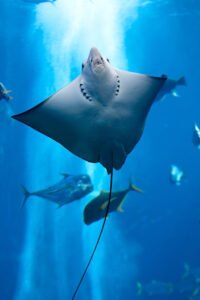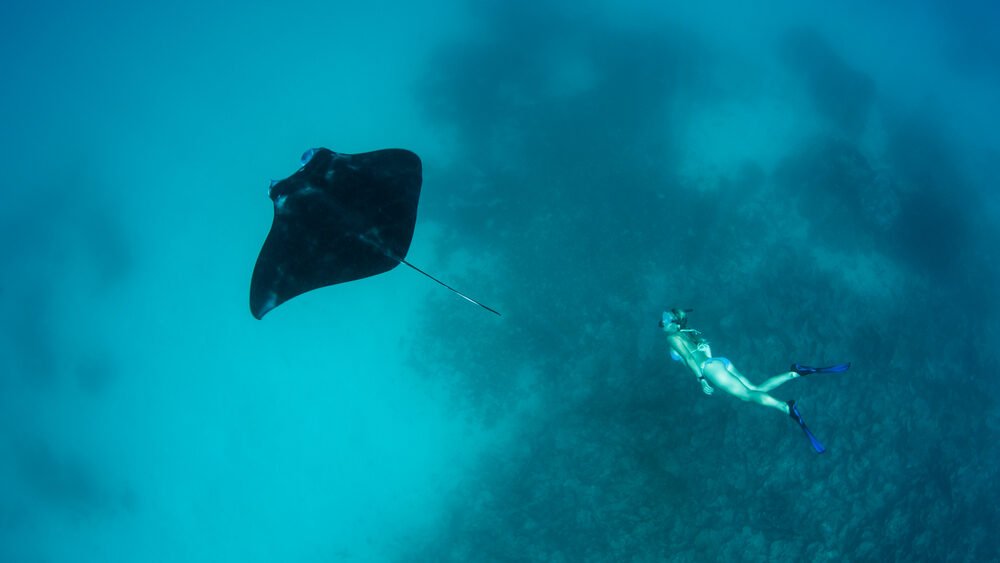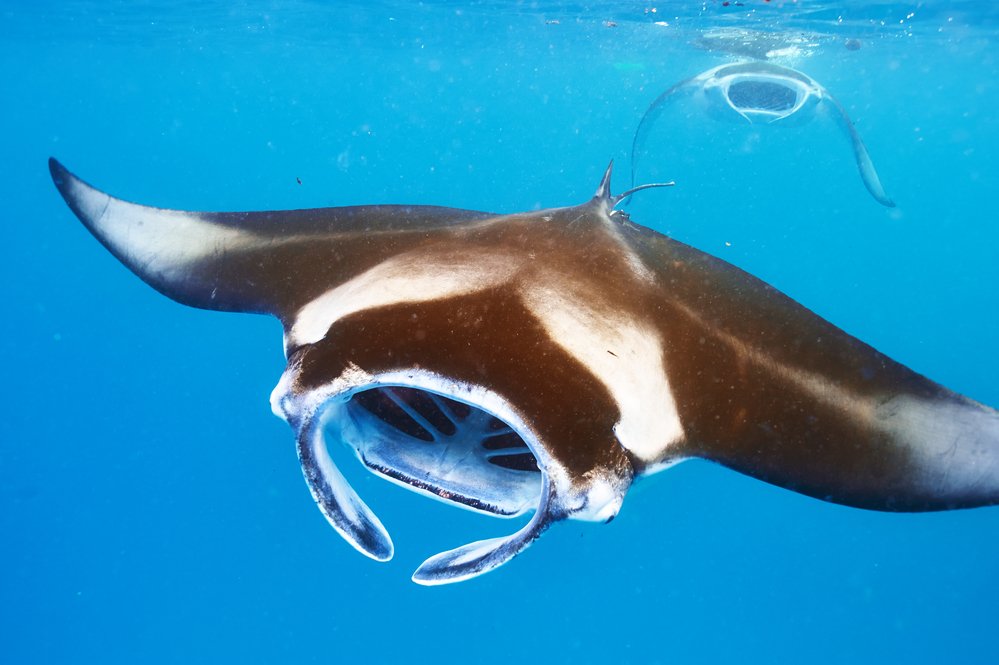9 Amazing Giant Manta Ray Fun Facts and FAQ
The Giant Manta Ray is an awe-inspiring sea creature, and here are a few quick fun facts to learn about them:

- It can grow up to nearly 23 feet in width, or 7 meters.
- It can weigh 3,000 pounds, and the world record from 1933 is 5,000.
- Amongst the largest species of ray in the world.
- Feast on larger prey such as squid and mackerel, but mainly feed on plankton and small fish.
- Have the ability to leap out of the water.
- They have intelligence.
- Able to display complex behaviors like somersaults and headstands, where they float vertically and wave their pectoral fins around in circles.
- They don’t have teeth or scales.
- Has smooth skin to reduce drag.
What are Manta Rays?
Manta Rays are one of the most iconic creatures of the deep ocean. They are a type of stingray with two species – the giant oceanic manta ray and the reef manta ray.
The giant oceanic manta can grow up to 7 meters in width, making them one of the largest fish on earth, while the reef manta is slightly smaller and has a wingspan of up to 5 meters.
Manta Rays are migratory species, meaning they travel across international waters, so they are protected by the Convention on Migratory Species.
Although they spend most of their time in open water, Mantas inhabit coral reefs and feed on various marine life.|
Their size makes them an impressive sight in the wild and a popular attraction for scuba divers worldwide.
Fun facts about Manta Rays include that they have no teeth or scales but instead have smooth skin that helps reduce drag while swimming through the water. They also feed mainly on plankton which they filter from the water with their mouths!
Characteristics

Manta rays are large, graceful creatures that inhabit the open ocean. They have a giant, triangular-shaped body and two large fins that look like wings, giving them their name.
They can grow up to 7 meters in width and weigh up to 2,300 kilograms. They have dark spots on their back, which they use as camouflage in the sea’s dark depths. Manta rays also have two horn-like structures on their heads known as cephalic lobes, which they use to turn corners and easily maneuver through the water.
What characterizes these animals is their giant mouths with keratin jaw plates to filter food from the water around them. Although they look intimidating due to their size, manta rays are harmless gentle giants that pose no danger to humans or other animals in their habitat.
Predators and Prey
Manta rays are filter feeders, meaning they consume their food by filtering tiny organisms from the water. They feed primarily on zooplankton and other tiny organisms like shrimp and krill.
They have few natural predators in the wild due to their large size but are sometimes preyed upon by sharks, killer whales, and large fish like tuna. The largest predator of manta rays is humans, who often hunt them for their meat or gill rakers which are used in some traditional medicines or for decorative purposes.
In recent years manta ray populations worldwide have been decreasing due to overfishing and habitat destruction, making conservation efforts more critical than ever.
Reproduction and Lifespan
Manta ray reproduction is difficult to observe in the wild, as the mating ritual usually takes place far away from human eyes. The female usually releases a pup following closely behind her after a gestation period of 12 to 13 months. Manta rays reach sexual maturity at an estimated age between 5 and 8 years old.
Their lifespan in the wild can be up to 25 years, although some live much longer. They are solitary creatures that live independently but can also live in groups or pairs during mating season. Reproduction and growth rates vary depending on the species and habitat of manta rays. Still, they need to reproduce more quickly to sustain their population numbers when it comes to human activities such as overfishing and water pollution.
Conservation Status

The International Union for Conservation of Nature (IUCN) has recognized the manta ray as a vulnerable species. Their population has been declining due to overfishing and other human-caused disturbances, such as habitat destruction and entanglement in fishing gear. They are also considered vulnerable to climate change due to their sensitivity to temperature changes.
Several countries have established protected areas and regulations to reduce fishing pressure on these animals and promote sustainable tourism involving manta ray encounters to help protect them.
In addition, researchers try better understand their migratory patterns and habitat preferences so that conservation efforts can be more effective. Although the situation is improving, there is still much work to be done to ensure manta rays’ survival in the future.
Manta Ray in Fishing and Cooking
In some parts of the world, people fish manta rays for their meat, a highly valued delicacy with a mild flavor. People cook it in various ways to create an exciting and tasty meal. When cooking manta rays, freshness is essential for a good taste. Grilling or baking are popular methods for cooking manta rays, but chefs make ceviche and sushi with the meat. If you’re looking for a unique seafood dish, consider trying manta ray!
Scientific Classification and Ray Species
Manta rays are a species of fish belonging to the genus manta within the family Mobulidae. They are one of the largest species of ray.
Manta rays belong to the genus Mobula, but it used to be in its “manta” genus, which is now obsolete. Recent DNA analysis confirms that manta is a junior synonym of Mobula. It belongs to the Mobulidae family, which includes manta rays and devilfishes, large species that live in the open ocean.
- Kingdom: Animalia
- Phylum: Chordata
- Class: Chondrichthyes
- Order: Myliobatiformes
- Family: Mobulidae
- Genus: Mobula (previously Manta)
Manta Ray vs. Stingray

The difference between manta and stingrays is their shape, appearance, size, and danger. Both are cartilaginous fish, but they differ in many ways.
The most crucial difference is that manta rays are not dangerous and do not pose any harm or toxicity to humans. In contrast, stingrays are venomous and have a stinger that can pierce human skin and cause pain and injury, often when stepped on.
Manta rays have large triangular-shaped fins, which give them a distinctively broad appearance. Their bodies are flat and rounded, while their mouths are on the underside of their heads.
Stingrays have diamond or disc-shaped bodies with a flat bottom and a pointed top, and they also possess a long, slender tail with a venomous stinger. Unlike manta rays, the mouth of a stingray is at the front of its body.
Additionally, manta rays can grow up to 7 meters long and weigh over 2 tons, whereas the largest species of stingray only reach up to 3 meters in length and weigh less than 400 kgs. This size difference makes manta rays easier to spot at sea than stingrays.
Manta ray vs. Devil Ray
Manta- and devil rays are both types of rays that belong to the Myliobatiformes order. Still, the most distinct difference is their body shape: Manta rays have much larger bodies than devil rays. Also, manta rays feed mainly on plankton, while devil rays feed on small fish, crustaceans, and invertebrates.
Reef and Giant Manta Ray FAQ

Where to dive or swim with Manta Rays?

If you want to swim with manta rays, you need to find them where they live, in tropical and subtropical oceans worldwide, with their range extending from the Red Sea and South Africa on one side to Hawaii and Mexico on the other.
Of the two species of manta ray, the reef manta ray stays in shallow waters close to coral reefs, whereas the giant manta ray migrates between regions.
Popular spots for meeting these creatures are Mexico, Hawaii, Qatar, Australia, and Indonesia, and you might find diving and snorkeling tours in the tourist areas of these regions.
While swimming with manta rays is an incredible experience, please remember to maintain a respectful distance so as not to disturb them or cause unnecessary distress. Seeing this creature is one of the divers’ and snorkelers’ most thrilling underwater activities.
Are manta rays dangerous, and can they kill or hurt humans?

No, manta rays are not harmful, as they do not have a stinger and are not poisonous. Some people confuse manta rays with their close relatives, some of which have a toxic stinger and can pierce human skin, such as the stingray. Manta rays are gentle giants of the ocean and pose no danger to humans.
What does a manta ray eat?
Manta rays feed on plankton and small fish.
Where do manta rays live?

Manta rays’ habitat is tropical waters and can be found off the coasts of Australia, Mexico, India, Indonesia, and the Philippines, to name a few.
They like to swim in reefs and sometimes migrate to other areas.
How to draw a manta ray?

Start by sketching the basic outline of the manta ray, including its head and wings.
Next, add details like eyes, mouth, and gills. Draw the fin and tail for the manta ray.
Finally, you can add colors and shadows if you want more detail. See the sketch example here to get started with your drawing.
How much do manta rays weigh?
Manta rays typically weigh between 600 and 1,320 lbs. or between 272 and 599 kg.
Do manta rays lay eggs?

No, manta rays do not lay eggs, as they are ovoviviparous. After mating, they keep the fertilized eggs in their oviduct, where embryos first hatch, and the pups stay the entire gestation (pregnancy) period for 12-13 months until they are ready for live birth. The manta only gives birth to one or two pups at a time.
Do manta rays have predators?
Yes. Manta rays have predators, including sharks, orcas, and humans.
How do manta rays defend themselves against predators?
Manta rays protect themselves against predators by using their size and speed to evade predators and their horn-like cephalic fins to direct water over their gills to deter predators.
Can you cook manta ray, and how does it taste?
Yes, you can cook manta rays. It has a mild taste, a mix of sweet and oily. You can grill, bake, and use a light sauce or marinade to bring out its flavor.
Are manta rays friendly?

Manta rays are among the most gentle creatures in the ocean, and they can be seen peacefully gliding through the water and interacting with people in a friendly manner. Despite their large and intimidating appearance, they are pretty docile, rarely showing aggression towards humans or other animals.
They sometimes approach divers, snorkelers, and swimmers and allow them to swim alongside them. They can play with each other in groups and perform graceful acrobatics for onlookers. While it is always important to exercise caution when interacting with wild animals, manta rays are generally considered safe, and enjoy watching from a distance.
Do manta rays have a backbone?

Not precisely. Manta rays do not have bones, as their skeleton consists of cartilage. But they have a vertebral column in the middle of their bodies, which we could call a backbone; even though it’s not bone, it serves the same biological function.
Is manta ray snorkeling safe?

Manta ray snorkeling is a safe and popular activity for people of all ages, and National Geographic has featured manta ray snorkeling as an adventure of a lifetime. You can get close enough to witness their graceful somersaults in the water. But please be aware that the species is vulnerable, and it’s essential to ensure that your excursion follows responsible practices and doesn’t contribute to any further decline in population numbers. With careful consideration, snorkeling can be a safe and rewarding activity.
Do manta rays have teeth?
No, manta rays do not have teeth but instead have a set of keratin jaw plates to filter food from water, acting like a sieve, trapping tiny organisms like plankton, small fish, and crustaceans to eat.

